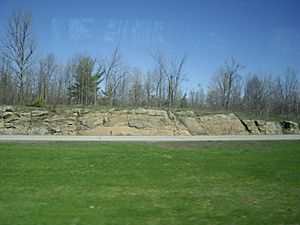Thousand Islands – Frontenac Arch facts for kids

The Thousand Islands – Frontenac Arch is a special natural area in Canada and the United States. It's like a bridge made of very old rock. This rock connects the Canadian Shield (a huge rocky area in Canada) to the Adirondack Mountains in New York. This area is super important for many plants and animals. It helps them move between these two big natural regions. The Arch also separates two large flat areas: the St. Lawrence Lowlands and the Great Lakes Lowlands. You can find many unique plants and animals here that you might not see elsewhere.
Contents
Ancient Rocks of the Arch
The rocks in the Frontenac Arch are incredibly old. Most of them are gneiss, granite, and marble. These rocks are more than a billion years old! The Frontenac Arch itself is about 1.2 billion years old. These ancient rocks were once part of a huge mountain range. This range was part of an even bigger landmass called Rodinia, which was an ancient supercontinent. There is also a special place near Holleford where a meteor hit the Earth a long, long time ago. This spot is where the old rocky shield meets the flatter limestone plains.
Amazing Plants and Animals
The Frontenac Arch is a unique place for nature. It has many types of trees and plants that usually grow much farther south. This area is their most northern home.
Rare Habitats and Species
Because the soil is often thin and there are sometimes natural fires, the area has special "fire barren" communities. These places are home to rare plants like bear oak and deerberry. They also provide homes for unusual animals. For example, you might find the five-lined skink (a type of lizard) and the gray rat snake here. The area also has many different kinds of birds. One special bird is the cerulean warbler. This bird is considered endangered because its forest homes are disappearing.
Forests Through Time
The main type of forest here is a temperate deciduous forest. This means the trees lose their leaves in the fall. For a long time, people have been cutting down trees in this area. This has made the forests lose their biggest trees. People often settled in places with deeper soil. Fires have also shaped the higher, rocky areas. Old records show that some trees, like hemlock, were cut down a lot for making leather. Scientists are now working to help these forests grow back to how they used to be. This means having bigger trees, more spring flowers, and more fallen logs on the forest floor.
Wetlands and Water Life
The Frontenac Arch has many different kinds of wetlands. These include large marshes along the Saint Lawrence River. There are also smaller marshes and bogs along streams. You can find many beaver ponds too. Beavers are busy builders! Their activity creates different types of wetlands. Depending on how active the beavers are, you might see open water, marsh, wet meadows, or thick bushes. Some lakes in the area, like Bob's Lake, are home to special turtles. These include map turtles and Blanding's turtles. In places where there is marble rock, or other sources of calcium, you might find special wetlands called fens. These fens often have unique plants that need calcium to grow.
Protecting the Arch
A southern part of this region was named a Biosphere Reserve by UNESCO in 2002. It's called the Frontenac Arch Biosphere Reserve. Inside this reserve is a smaller place called Thousand Islands National Park. Even though it's small, this park protects many of the special plants and animals of the Frontenac Arch. This includes deerberry, Blanding's turtles, and five-lined skinks. Farther north, there is still a big gap in the natural connection to Algonquin Provincial Park. In this gap, you can find smaller parks like Frontenac Provincial Park and Bon Echo Provincial Park.

